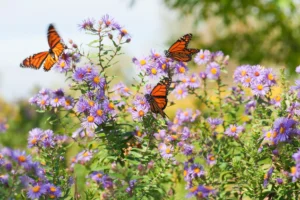- 302-539-1839
- Hours: Mon-Sat 9am-4pm, Sun 10am-3pm

We all know that it is important to have milkweed (asclepias incarnata) and butterflyweed (asclepias tuberosa) for monarch butterfly caterpillars (danaus plexippus) to eat — but do you know why?
Asclepias are the exclusive host plants for monarchs, which means that the two have evolved over eons to co-exist together. The monarchs have learned how to tolerate and use the toxins in the milkweed to protect themselves from predators. Without this plant, we would not have any monarchs!
However, just as important to monarchs are the nectar-rich plants they need when they emerge from their chrysalises. I have listed many of them below, so be sure to bring this list with you to your local native garden center.
A few of my favorites are the blue mist flower for shady areas, the monarda (also loved by hummingbirds), fall asters, liatris and coneflowers, and a must-have are the different varieties of goldenrod, as each type blooms at a different time. If you only have room for one, do the seaside goldenrod, as it continues to bloom later in the fall. The best butterfly garden is one that provides food for caterpillars, as well as essential nectar for butterflies.
Plants you should never grow for monarchs are the tropical milkweed (asclepias curassavica), as it disrupts their migration, which causes an increase in parasitic protozoan (ophryocystis elektroscirrha). This shortens the butterfly’s lifespan and inhibits their ability to fly.
Another no-no is the invasive butterfly bush (buddleja davidii). This bush is native to Asia and has great nectar for those butterflies that evolved with it. Conversely, our native butterflies do not receive adequate nectar from these bushes. In fact, they waste time visiting this bush instead of going to our native flora that will give them the nectar they need for their long journey to Mexico. For them, feeding at a butterfly bush is like feeding candy to a baby — they love the taste but will not get the strong bones and muscles needed to grow.
Great nectar plants for monarchs
Achillea millefolium — yarrow
Baccharis halimifolia — Eastern baccharis (groundsel)
Cephalanthus occidentalis — buttonbush
Conoclinium coelestinum — blue mistflower
Echinacea purpurea — purple coneflower
Eupatorium perfoliatum — common boneset
Eutrochium fistulosum — Joe-Pye weed
Gaillardia — Blanket flowers
Helianthus — sunflowers
Liatris spicata — blazing star
Monarda fistulosa — wild bergamot
Monarda punctata — spotted bee balm
Pycnanthemum — mountain-mints
Rudbeckias — black-eyed Susan
Solidago sempervirens — seaside goldenrod
Symphyotrichum — asters
Vernonia noveboracensis — New York ironweed
Annuals
Cosmos
Marigolds
Tithonia rotundifolia — Mexican sunflower
Zinnias
Fun facts
• Monarch butterflies fly more than 3,000 miles.
• They must have milkweed for survival.
• Their last generations can live up to nine months to complete their long journey south.
• The earlier generations live two to six weeks.
• Their orange-, black-and-white coloring warns predators of their toxicity.
• Monarchs use the sun and the Earth’s magnetic field to navigate.
• Male monarch butterflies are identified by a black dot on each of their hind wings.
• A bunch of monarchs are called a flutter (of course)
• They have beautiful gold-studded chrysalises.
• They huddle and roost on tree trunks for warmth.
• A monarch caterpillar can eat more than 200 times its weight.
• Monarchs grow more than 2,500 times their original size.
• They eat the skins they shed (yuck!)